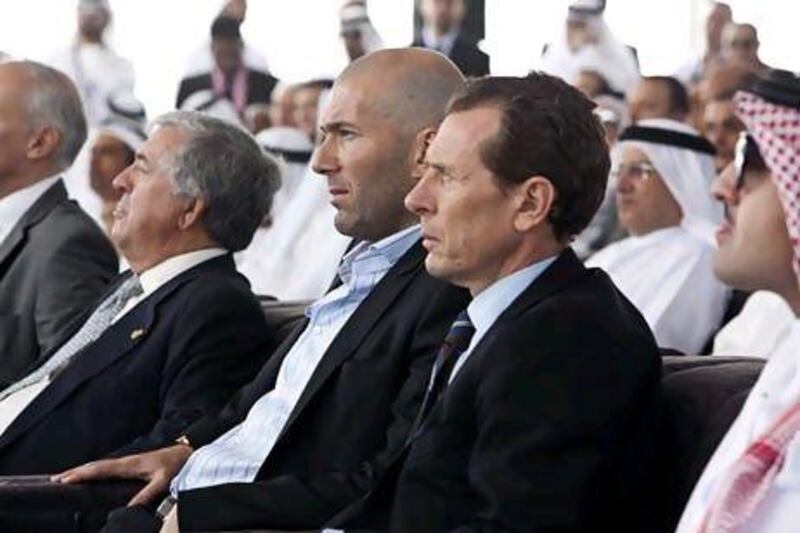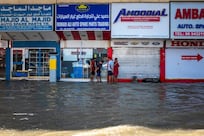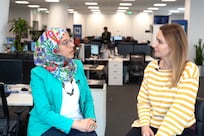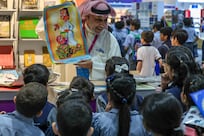Zinedine Zidane and Emilio Butragueno, the former football stars,attracted adoring fans when they played for Real Madrid in Spain. Now they are attracting property developers.
Last week, the two sports heroes were chauffeured to a large tented venue on a vast expanse of reclaimed land on the coast of Ras Al Khaimah.
The purpose of their visit to the sleepy industrial emirate was for a proposed US$1 billion (Dh3.67bn) Real Madrid resort.
Zidane, now a director of football at Real Madrid, and Butragueno, the director of institutional relations at the club, were there to promote the development, designed to include a theme park, hotel and stadium.
The project is expected to be financed through the private sector after a series of high-profile regional and global roadshows.
"It is without doubt the best advertisement we could have," says Khater Massaad, the chief executive of the RAK Investment Authority. "We look forward to opening our doors … as Ras Al Khaimah takes one step further to making its mark on the world map."
Such fanfare and international attention surrounding an ambitious announcement is a familiar occurrence in Dubai and Abu Dhabi. But the UAE's other five emirates are often left in the shadows, although they all demonstrate tourism ambitions of their own as they, too, strive to diversify and expand their economies.
Travel and tourism's direct contribution to the UAE's economy is expected to grow by 4.2 per cent a year to reach Dh132.4bn, or 7 per cent of GDP, by 2022, according to the World Travel and Tourism Council.
"There is a conscious effort by other emirates to promote themselves as attractive business and leisure destinations," says Gaurav Sinha, the managing director of Insignia, a brand communications firm which specialises in travel.
In the case of Ras Al Khaimah, it is hoping that tourism will make up 20 per cent of its economy by 2021 and generate in excess of $1bn a year.
The plan for the Real Madrid resort is just part of this. The emirate is already building a Dh700 million Waldorf Astoria hotel, which is Hilton's most luxurious brand.
It is also set to open an all-inclusive Dh500m luxury resort to be managed by the Turkish operator Rixos later this year.
"We are looking in Ras Al Khaimah not just to have hotel management, but also investment opportunities," says Fettah Tamince, the chairman of Rixos Hotels.
Sharjah is another region that considers tourism vital to its economy. The emirate actively promotes itself as a tourism destination at trade fairs all over the world, advertising its museums and cultural heritage as its main attractions.
Khor Fakkan, a town on the east coast, which is geographically separate from the main city, hopes to develop into a resort hub.
"We need to promote it more aggressively," says Mohamed Ali Al Noman, the chairman of the Sharjah Commerce and Tourism Development Authority. "It's still like unexplored territory. We have to tap its immense potential. [We are] constantly exploring ways and means to boost the tourism industry in the emirate."
Fujairah is doing the same thing. The emirate, with its rugged mountains and location on the Gulf of Oman, is a popular weekend escape destination for UAE residents. Three years ago, it set up Fujairah Tourism & Antiquities Authority as it stepped up its efforts to attract more visitors and investment in the sector. Ajman and Umm Al Quwain have also joined the growing queue to lure visitors to their regions.
But if they want to be successful they will all need to invest in building the right image.
"It is a matter of branding," says Chiheb Ben Mahmoud, the head of hotel advisory at Jones Lang LaSalle Hotels, Middle East and Africa.
"Sharjah, Fujairah and Ras Al Khaimah are already tourism destinations in their own rights in terms of number of tourists received and tourism activity. It is, however, the branding side of the destination that is understated."
This is by no means an easy process, he explains.
"Branding a destination is a long and costly process," he says. "Consistency is key."
While destinations such as Ras Al Khaimah and Fujairah have strong attributes and propositions, the initiatives taken so far have not seemed to get the message fully across.
"It is hoped the strategies in place and being implemented will achieve the desired results and the objectives. Iconic and exclusive hotel developments could play a role, but are no substitute to a full and comprehensive marketing strategy," says Mr Mahmoud.
And the other emirates are not established as aviation hubs.
"The Northern Emirates of the UAE follow, normally, the lead of Dubai and Abu Dhabi with new property, aviation and hospitality projects," says Omer Kaddouri, the chief operating officer at Rotana Hotels,one of the largest hotel operators in the UAE.
"According to our recent research, travelling within the UAE, the GCC and, more widely, across the Middle East and Africa, is definitely catching on, especially after the Arab Spring last year," he adds. "Our resorts in the Northern Emirates are fully booked at weekends. With more budget airlines operating in this region, local travel is becoming even better value."
Industry experts say what is needed now is a more united approach to tourism by the different emirates.
"The UAE would benefit exponentially by promoting the nation at a federal level," says Mr Sinha.
To some extent there have been steps toward this, he explains, with the National Council for Tourism & Antiquities developing marketing initiatives under the slogan of "Seven Emirates, One Destination".
"We need more international awareness about the easy access to some of the neighbouring emirates and what they offer, says Mr Sinha.
"It is in the interest of Dubai and Abu Dhabi, as people want to know what else there is to explore and discover in the UAE. The country offers unique Arabian experiences that await international visitors beyond the city lights of these burgeoning metropolises."
In the meantime, Zidane and Butragueno are not doing a bad job raising the profiles of emirates outside of Abu Dhabi and Dubai
twitter: Follow our breaking business news and retweet to your followers. Follow us





